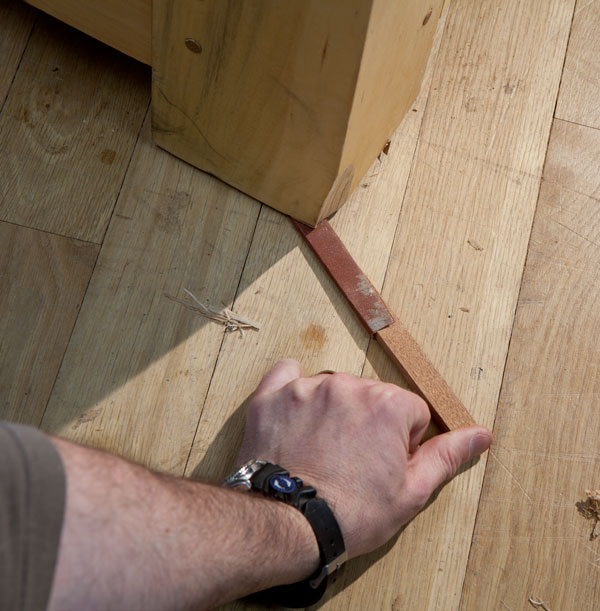We may receive a commission when you use our affiliate links. However, this does not impact our recommendations.
While this isn’t the dumbest shop trick ever (that honor belongs to: “A coffee mug is a good place to store pencils”) it’s close.
About six months ago, I became crazy annoyed about my workbench moving while under heavy planing. The bench weighs about 350 pounds, so it wasn’t a matter of mass.
For some reason I picked up the wooden wedge jammed under one of the legs that keeps the bench from rocking on the floor. I adhered a bit of #120-grit PSA sandpaper around the wedge and jammed it back under the short leg.
Today I remembered the sandpaper wedge when I tried to move my bench for an operation. The sucker wouldn’t budge until I removed the wedge. Then it dawned on me: My bench hadn’t scooted anywhere in months.
If your bench won’t stay put, give it a try. It’s simpler than the other solution I considered: bolting the sucker to the floor.
— Christopher Schwarz
Here are some supplies and tools we find essential in our everyday work around the shop. We may receive a commission from sales referred by our links; however, we have carefully selected these products for their usefulness and quality.










Most of my work is done on my portable bench. If it starts to move I can just set my right foot against the right leg which locks it in place. That also gives me something to push against to get that plane all the way through the cut. I’ve been able to do most anything i need on that relatively small bench. Like that wedge, i think the simplest solutions are the best.
Wow, Chris! What a tough crowd! If anyone doubts the “No good deed goes unpunished” rule, show them these comments as evidence.
I think you offered a good solution to this problem. Your bench can weigh 1,000 pounds, but if each of the 4 legs is not bearing down on the floor equally, it will walk when pushed from a certain direction.
The question is: are the legs of your bench on the same plane as your floor? If not, it will rock, and if it rocks, it will walk. Maybe not in the spring when you built it, but how about the following winter?
I like the rubber stall mat suggestion, but be advised, the rubber smell is rather obnoxious for the first several months. And they do raise your bench by 3/4″.
Hey, wait! Your solution doesn’t smell at all!
And what’s the deal about pencils in a coffee mug? Is that dumb or just master-of-the-obvious? Whatever container you choose, crumpled-up paper towels in the bottom keeps the points from getting beat up.
My bench has steel legs, and they were always sliding across my concrete floor when using my belt sander. Finally, I realized that the obvious solution was to mortice the bench legs into the concrete using some old cold chisels and a 3# crosspein hammer. The chisels sure didn’t last long-they had oval handles which splintered, and the cutting edges chipped badly. I think they were tempered poorly. Weather-something. Don’t reccomend them at all.
Festool makes the perfect wedge solution. Only comes in metric sizes but your bench can be modified to make them fit. Some will balk at the the price until you try them; another case of you get what you pay for. You will find your bench not only doesn’t move; it learns to lean into your horizontal vector while planning. Comes complete with systainer to hold the space that the wedge originally occupied.
My bench sits on a 4’x6′ heavy duty rubber gym floor mat. The bench doesn’t move and the ~2′ track of mat in front of the bench means I don’t have to stand on concrete.
http://www.fitnessfactory.com/Home/Item/5316/RF546/Heavy_Duty_Rubber_Floor_Mat/
I guess the wedge thing escapes me. My bench top weighs more than Chris’ whole bench and all sits on epoxy coated floor paint i.e.(it used to be a garage) and it doesn’t budge even under heavy planing. NOTHING beats mass. Use the inertia, Luke…
I think Roy Underhill has made a video on this problem. 🙂
I think you’ve overcomplicated this one. Wooden floor + wooden bench? Just glue them together. Then if you ever need to move it, all you have to do is saw the legs off and plane down the stumps on the floor. Easy.
Where can I buy one of these “wedges”?. What wood is the best wood for it? Can somebody please make a DVD on how to tune my wedge? Is a bevel up or bevel down wedge better?
This trick is employed by at least one laundry machine manufacturer to prevent an unbalanced front load washer from “walking.” They use 60 or 80 (?) grit self- stick abrasive pads, about 2″x 3,” placed grit side up under the washer’s feet. Should work well for benches on hard, smooth (concrete or laminate) shop floors.
Cf ‘Death by Roubo’ … floor cleats. 🙂
Sure wish I had one of those fancy wood floors in my shop
I complained online about the same problem and a helpful fellow suggested I put some rubber under the legs. I cut some squares from an inexpensive Woodcraft mat and it worked like a charm.
Your solution doesn’t add 3/8″ of height to the bench, though.